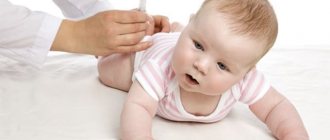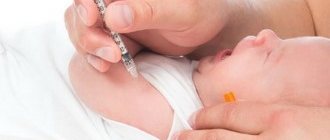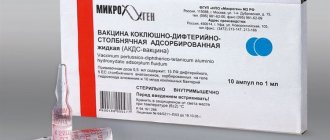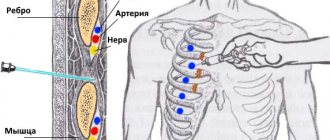Everyone knows about the need to vaccinate children. There are several routine vaccinations that are given to infants. This is, in particular, DPT. Many parents have a question: why is their baby suddenly vaccinated not in the arm, not in the buttock, but in the thigh (in the anterolateral part of it), because this may seem illogical and incorrect to someone.
And immediately anxiety arises that something is wrong with the child. In fact, vaccination in the leg is an absolutely normal practice. Below we explain the reasons why this is done, and also discuss the possible consequences of such vaccination.
Why do children get leg shots?
All parents need to know that injection of any vaccines into the buttock is highly discouraged for children under three years of age:
- in the gluteal region, adipose tissue predominates, which interferes with the normal functioning of the vaccine and the formation of immunity;
- there is a high risk of mechanical damage to the sciatic nerve and large vessels, which can lead to severe inflammation and even disability.
Based on these features and in accordance with the decree of the sanitary doctor and WHO recommendations, in children under three years of age, the injection site for any vaccines is the middle third of the anterolateral surface of the thigh. For older children, as well as adults, vaccines are placed in the lateral surface of the arm, in the deltoid muscle of the shoulder.
Every parent has every right to control not only the quality of the vaccine, but also the method of vaccination.
Why are vaccinations given in the thigh and not the buttock?
The anterolateral thigh area is the most preferred area for grafting. Why? The fact is that piercing in this place is the safest, since damage to large vascular structures and nerve formations is impossible, since they simply do not exist in this area of the thigh.
But the gluteal muscles in children are not used for vaccination due to:
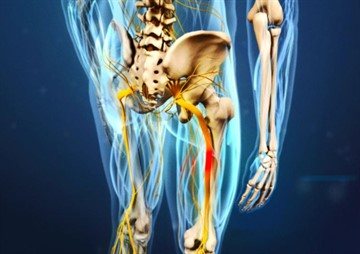
- there is a high risk of puncturing the sciatic nerve. This is very painful and can paralyze the patient;
- the likelihood of touching the nerve trunks if they are abnormally located, which is diagnosed in 5% of children.
In addition, there is too much fat in the buttock area. This means that the injected suspension may not enter the muscle, but the adipose tissue.
In this case, the medicine will take a long time to dissolve, and an abscess is likely to form at the puncture site.
If a drug is prescribed for the procedure with intramuscular injection (that is, into the thigh or shoulder), make sure that the injection is placed exactly in the child’s leg. Do not rely on official (free) materials. Buy syringes with needles of suitable length in advance: for babies they use short and thin ones.
What vaccination is given to children's legs?
The main vaccination, which should be given specifically in the leg (femoral part) of children under two years of age, is DPT. It contains pertussis vaccine and purified concentrated diphtheria and tetanus toxoids. DTP begins at 3 months, then at 4.5 and then at 6 months.
Revaccination is carried out at 18 months, then at 6-7 and 14 years, and then every 10 years. For the first four vaccinations (full course of vaccination), DPT is used. And subsequent revaccination is carried out with the ADS vaccine without the pertussis component.
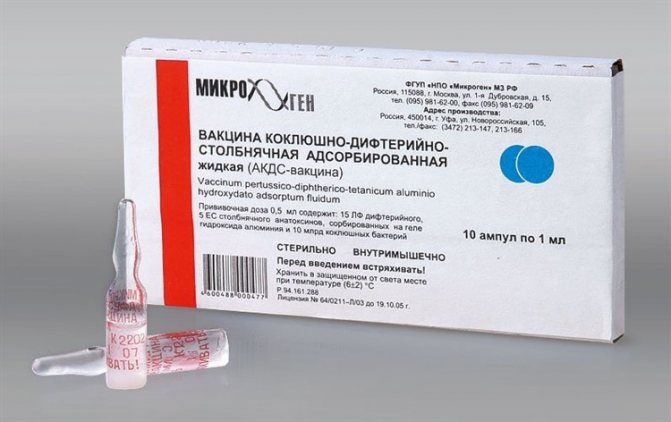
DPT vaccine
Today there are vaccines combined with DTP:
- Pentaxim (DPT + polio + hemophilus influenzae infection);
- Tetrakok (DTP + polio);
- Tritanrix-NV (DTP + hepatitis B).
The pertussis component is the most severe for the body. It causes a strong response from the child’s body, and therefore in our country revaccination is carried out without pertussis vaccine.
For revaccination, the following vaccines without the pertussis component are used:
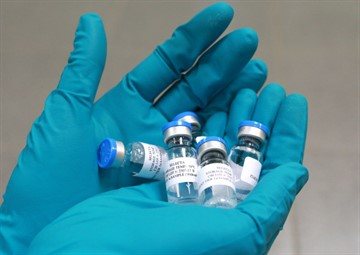
- ADS (domestic) and D.V.Vax (foreign) - against diphtheria and tetanus;
- children aged 6 years are given ADS-m (“m” means toxoids with a reduced content of the active substance) and Imovax D.T.Adult – against the same diseases;
- AS – separately against tetanus;
- AD-m – separately against diphtheria.
The DTP vaccine is currently considered one of the most severe. Sometimes it gives a strong response in children. Naturally, parents have questions about the need for vaccination, and some refuse vaccination altogether.
Such parents need to be reminded that the infant mortality rate for diphtheria is 50%, for tetanus - 80-90%. Before mass immunization, almost 100% of children suffered from whooping cough; many had serious complications.
Compliance with all medical rules for vaccination allows you to minimize the risk of complications, but guarantees the formation of reliable immunity against extremely dangerous diseases in the child.
Consequences of injection of the vaccine into the thigh
The DPT vaccine contains artificially killed pertussis germs, and it is to this component that, as a rule, children develop allergies and other undesirable consequences. For the first time, DTP is given at 3 months, when a natural decrease in protective properties occurs, and this, in combination with the introduction of foreign agents (albeit non-living), leads to negative reactions of the child’s body.
Post-vaccination reactions are divided into two main groups:
- local;
- general, when somatic reactions of the whole body are observed (malaise, high temperature and other changes in well-being).
Local reactions include:
- compaction and redness at the site of DPT injection. Such changes last for 2-3 days, which is considered normal. If the swelling and redness do not go away or increase, you should immediately consult a doctor;
- Sometimes a local allergic reaction is observed, manifested by hyperemia and swelling. Often this is a normal response of the child’s body to the introduction of a foreign substance (in this case, toxoids and non-living pertussis microbes);
- if a lump appears at the site of DTP administration and it increases, this condition may indicate an acute purulent inflammatory process due to infection during vaccination. This condition requires urgent medical intervention;
- If the child feels severe pain, anxiety, or limps on the leg where the vaccine was injected, this may indicate an incorrect injection site and nerve fiber damage. A doctor's consultation is required.

Common ones include:
- toxic reactions, expressed by vomiting, hyperthermia, rapid deterioration in health. The child becomes restless, irritable and whiny;
- damage to the nervous system, expressed by the child’s anxiety, prolonged screaming, and the appearance of seizures. However, such reactions are often temporary.
Parents should understand that when vaccinated with DTP, the baby’s immunity decreases, and when a concomitant infection occurs, a cough, sore throat, and redness of the tonsils are sometimes observed for several days.
If any manifestations of undesirable reactions in a child to DPT, it is necessary to contact a pediatrician as soon as possible in order to avoid serious complications.
How to help a child with leg pain?
If a child is afraid to stand on his leg, constantly lies down, and complains of unbearable pain, you can lubricate the area with Troxevasin. Some inexperienced nurses, instead of injecting the suspension into the muscle, inject it under the skin. There is a lot of fat under the skin, but there are practically no blood vessels, so the infiltrate begins to be slowly absorbed. The pain will continue until the suspension begins to dissolve. What to do? Consult your pediatrician, maybe he will prescribe an ointment - Aescusan, it improves blood circulation and helps the drug to be absorbed faster.
Rarely, an infection can occur during vaccination. This happens when sanitary and hygienic standards are violated during the injection, as well as after mechanical impact on the injection site. In this situation, the wound begins to bleed heavily and fester. The child cannot stand on his feet at all and does not want to walk. You can’t hesitate, you need to immediately show the baby to the surgeon, who will clean the wound of pus. If this is not done in a timely manner, everything will end in an abscess.
Does your leg hurt a lot after DTP? Is your baby constantly crying? Give a pain reliever, such as Nurofen. You cannot torture a child and force him to endure pain; also be sure to bring down the high temperature. After vaccination, your first aid kit at home should have: antiallergic, pain reliever and antipyretic.
What is the conclusion? The reaction to vaccination is considered normal, thus forming an immune response to the introduction of bacteria. For some children it is unnoticeable, but for others it is very difficult. It is acceptable if the injection site swells a little and a lump appears. During the first days, the child may cry from pain, pull his leg, and sometimes even refuse to stand on it. No need to panic! Your doctor will usually warn you about these side effects. You need to urgently call an ambulance and go to the hospital if the temperature has risen sharply, the child is screaming loudly, the leg is very hot and red, and the injection site is festering. Here you cannot do without medical help. In other cases, all unpleasant symptoms disappear on day 4 or a little earlier. Despite a number of side effects, you should not refuse the vaccine; infections can cause much more harm!
What to do if your baby’s leg hurts after vaccination?
Sometimes after the injection the child complains of pain in the leg.
But if the symptoms are minor or moderate, then this is quite acceptable. DPT often causes a local pain reaction, which goes away on its own on the third day. Of course, you can use some pain-relieving ointments and gels, as well as some traditional methods, for example, applying cabbage leaves or peeled potatoes. But self-medication is unacceptable, since generally accepted pain-relieving procedures can have the opposite effect when reacting to DTP.
Therefore, the use of any medications, as well as the use of traditional methods of treatment, is possible strictly after consultation with a doctor in order to avoid negative reactions and serious complications. If the pain is pronounced and causes severe anxiety in the child in combination with other negative reactions, it is necessary to urgently consult a doctor.
Local side effects
Unfortunately, DTP is considered a difficult vaccination, and not all children can safely tolerate it. In addition to general ailments and changes in behavior, there may be severe local reactions in the place where the injection was given:
- The appearance of redness.
- Strong pain.
- The leg is swelling.
Please note that pain with induration is considered normal if the temperature is not higher than 38 degrees. The pain appears due to the fact that aluminum hydroxide enters the muscle; it is responsible for the immune response. This compound helps to keep the suspension in the place where it was introduced for a long time.
A reaction is considered normal when the injection site swells and turns red, while the child can calmly stand on his leg, does not act up, does not cry. The inflammatory process should not spread more than 5 cm. When the inflammatory area increases significantly, the child cannot walk and begins to limp - this is a complicated reaction.
Attention! It is forbidden to get rid of swelling and pain in the leg on your own. All procedures are agreed upon with the pediatrician.
Please note that when the baby begins to limp and pulls his leg, this means that the resorption of the infiltrate is happening too slowly. Swelling, pain and redness are common reactions. To restore motor function, you need to do a special massage.
How long can a child limp after vaccination? Usually after a week, lameness disappears, and the infiltrate is absorbed into the body tissue. If the swelling is too strong and the leg is hot, you need to urgently consult a surgeon. Perhaps he will prescribe a special medicinal ointment (often Fenistil gel), a special compress.
Video on the topic
A practicing allergist-immunologist on what to do if a child limps after a leg vaccination:
The DTP vaccine is considered quite difficult for a child’s body, and the vaccination period is a big burden on the baby himself and his loved ones. It is accompanied by worries, anxiety, visits to doctors and pharmacies. But this vaccine is one of the most necessary; it allows you to create reliable immunity against dangerous diseases.
And in order to get rid of doubts and unnecessary worries about the use of DTP, you need to consult with your doctor in advance on how to properly prepare the child and prepare yourself for this procedure.

